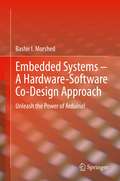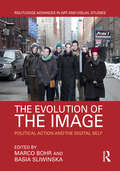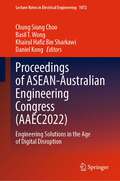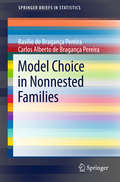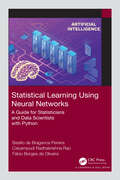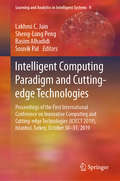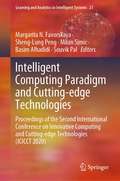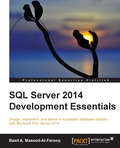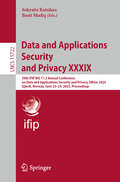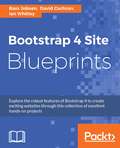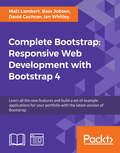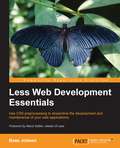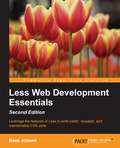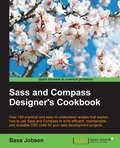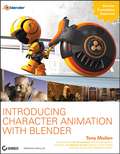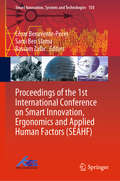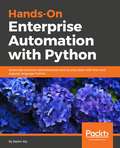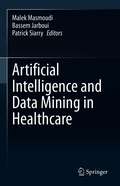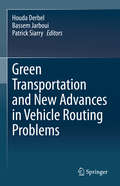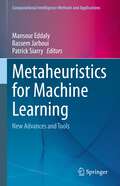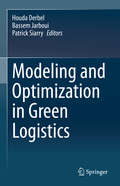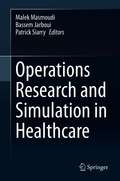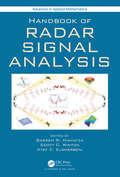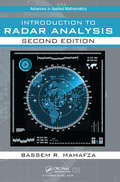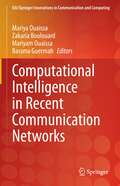- Table View
- List View
Embedded Systems – A Hardware-Software Co-Design Approach: Unleash the Power of Arduino!
by Bashir I MorshedThis textbook introduces the concept of embedded systems with exercises using Arduino Uno. It is intended for advanced undergraduate and graduate students in computer science, computer engineering, and electrical engineering programs. It contains a balanced discussion on both hardware and software related to embedded systems, with a focus on co-design aspects. Embedded systems have applications in Internet-of-Things (IoT), wearables, self-driving cars, smart devices, cyberphysical systems, drones, and robotics. The hardware chapter discusses various microcontrollers (including popular microcontroller hardware examples), sensors, amplifiers, filters, actuators, wired and wireless communication topologies, schematic and PCB designs, and much more. The software chapter describes OS-less programming, bitmath, polling, interrupt, timer, sleep modes, direct memory access, shared memory, mutex, and smart algorithms, with lots of C-code examples for Arduino Uno. Other topics discussed are prototyping, testing, verification, reliability, optimization, and regulations. Appropriate for courses on embedded systems, microcontrollers, and instrumentation, this textbook teaches budding embedded system programmers practical skills with fun projects to prepare them for industry products.Introduces embedded systems for wearables, Internet-of-Things (IoT), robotics, and other smart devices;Offers a balanced focus on both hardware and software co-design of embedded systems;Includes exercises, tutorials, and assignments.
The Evolution of the Image: Political Action and the Digital Self (Routledge Advances in Art and Visual Studies)
by Basia Sliwinska Marco BohrThis volume addresses the evolution of the visual in digital communities, offering a multidisciplinary discussion of the ways in which images are circulated in digital communities, the meanings that are attached to them and the implications they have for notions of identity, memory, gender, cultural belonging and political action. Contributors focus on the political efficacy of the image in digital communities, as well as the representation of the digital self in order to offer a fresh perspective on the role of digital images in the creation and promotion of new forms of resistance, agency and identity within visual cultures.
Proceedings of ASEAN-Australian Engineering Congress: Engineering Solutions in the Age of Digital Disruption (Lecture Notes in Electrical Engineering #1072)
by Chung Siung Choo Basil T. Wong Khairul Hafiz Bin Sharkawi Daniel KongThis book presents the proceedings of the ASEAN-Australian Engineering Congress (AAEC2022), held as a virtual event, 13–15 July 2022 with the theme “Engineering Solutions in the Age of Digital Disruption”. The book presents selected papers covering scientific research in the field of Engineering Computing, Network, Communication and Cybersecurity, Artificial Intelligence & Machine Learning, Materials Science & Manufacturing, Automation and Sensors, Smart Energy & Cities, Simulation & Optimisation and other Industry 4.0 related Technologies. The book appeals to researchers, academics, scientists, students, engineers and practitioners who are interested in the latest developments and applications related to addressing the Fourth Industrial Revolution (IR4.0).
Model Choice in Nonnested Families
by Basilio De Pereira Carlos Alberto PereiraThis book discusses the problem of model choice when the statistical models are separate, also called nonnested. Chapter 1 provides an introduction, motivating examples and a general overview of the problem. Chapter 2 presents the classical or frequentist approach to the problem as well as several alternative procedures and their properties. Chapter 3 explores the Bayesian approach, the limitations of the classical Bayes factors and the proposed alternative Bayes factors to overcome these limitations. It also discusses a significance Bayesian procedure. Lastly, Chapter 4 examines the pure likelihood approach. Various real-data examples and computer simulations are provided throughout the text.
Statistical Learning Using Neural Networks: A Guide for Statisticians and Data Scientists with Python
by Basilio de Braganca Pereira Calyampudi Radhakrishna Rao Fabio Borges de OliveiraStatistical Learning using Neural Networks: A Guide for Statisticians and Data Scientists with Python introduces artificial neural networks starting from the basics and increasingly demanding more effort from readers, who can learn the theory and its applications in statistical methods with concrete Python code examples. It presents a wide range of widely used statistical methodologies, applied in several research areas with Python code examples, which are available online. It is suitable for scientists and developers as well as graduate students.Key Features: Discusses applications in several research areas Covers a wide range of widely used statistical methodologies Includes Python code examples Gives numerous neural network models This book covers fundamental concepts on Neural Networks including Multivariate Statistics Neural Networks, Regression Neural Network Models, Survival Analysis Networks, Time Series Forecasting Networks, Control Chart Networks, and Statistical Inference Results. This book is suitable for both teaching and research. It introduces neural networks and is a guide for outsiders of academia working in data mining and artificial intelligence (AI). This book brings together data analysis from statistics to computer science using neural networks.
Intelligent Computing Paradigm and Cutting-edge Technologies: Proceedings of the First International Conference on Innovative Computing and Cutting-edge Technologies (ICICCT 2019), Istanbul, Turkey, October 30-31, 2019 (Learning and Analytics in Intelligent Systems #9)
by Lakhmi C. Jain Sheng-Lung Peng Souvik Pal Basim AlhadidiThis book discusses fundamental and high-level concepts relating to intelligent computing and communications in the context of distributed computing, big data, high performance computing and the Internet of Things. It is becoming increasingly important to develop adaptive, intelligent, computing-centric, energy-aware, secure and privacy-aware mechanisms in high-performance computing and IoT applications. Serving as a useful guide for researchers and practitioners working in the field of information technology and computer science, the book also appeals to beginners wanting to learn more about the better computing paradigm. In addition, it provides a platform for researchers, engineers, academics and industry professionals from around the globe to share their research findings.
Intelligent Computing Paradigm and Cutting-edge Technologies: Proceedings of the Second International Conference on Innovative Computing and Cutting-edge Technologies (ICICCT 2020) (Learning and Analytics in Intelligent Systems #21)
by Margarita N. Favorskaya Sheng-Lung Peng Souvik Pal Basim Alhadidi Milan SimicThis book aims to bring together Researchers, Scientists, Engineers, Scholars and Students in the areas of computer engineering and information technology, and provides a forum for the dissemination of original research results, new ideas, Research and development, practical experiments, which concentrate on both theory and practices, for the benefit of the society. The book also provides a premier interdisciplinary platform for researchers, practitioners and educators to present and discuss the most recent innovations, trends, and concerns as well as practical challenges encountered and solutions adopted in the fields of Computer Science and Information Technology in the context of Distributed computing, Big data, High performance computing, Internet-of-Things, and digital pedagogy. It is becoming increasingly important to develop adaptive, intelligent computing-centric, energy-aware, secure and privacy-aware mechanisms in high performance computing and IoT applications. This book aspires to convey researchers’ experiences, to present excellent result analysis, future scopes, and challenges facing the field of computer science, information technology, telecommunication, and digital pedagogy. This book aims to attract researchers and practitioners who are working in Information Technology and Computer Science. This book is about basics and high level concepts regarding intelligent computing paradigm, communications, and digital learning process. The book serves as a useful guide for Undergraduates, Postgraduates and Research Scholar in the field of Computer Science, Information Technology, and Electronics Engineering. We believe that this volume not only presents novel and interesting ideas but also will stimulate interesting discussions from the participants and inspire new ideas.
SQL Server 2014 Development Essentials
by Basit A. Masood-Al-FarooqThis book is an easy-to-follow, comprehensive guide that is full of hands-on examples, which you can follow to successfully design, build, and deploy mission-critical database applications with SQL Server 2014. If you are a database developer, architect, or administrator who wants to learn how to design, implement, and deliver a successful database solution with SQL Server 2014, then this book is for you. Existing users of Microsoft SQL Server will also benefit from this book as they will learn what's new in the latest version.
Data and Applications Security and Privacy XXXIX: 39th IFIP WG 11.3 Annual Conference on Data and Applications Security and Privacy, DBSec 2025, Gjøvik, Norway, June 23-24, 2025, Proceedings (Lecture Notes in Computer Science #15722)
by Sokratis Katsikas Basit ShafiqThis book constitutes the refereed proceedings of the 39th IFIP WG 11.3 Annual Conference on Data and Applications Security and Privacy XXXIX, DBSec 2025, held in Gjøvik, Norway, during June 23-24, 2025. The 19 full papers and 5 short papers included in this book were carefully reviewed and selected from 59 submissions. They were organized in topical sections as follows: AI applications in security and privacy; User and data privacy; Database and storage security; Differential privacy; Attackers and attack detection; Access control & Internal Controls and Audit process; and Cryptography for security and privacy.
Bootstrap 4 Site Blueprints
by David Cochran Ian Whitley Bass JobsenExplore the robust features of Bootstrap 4 to create exciting websites through this collection of excellent hands-on projects About This Book * Explore the inner workings of Bootstrap 4 by building different websites * Customize your designs by working directly with Bootstrap's SASS files * Leverage Bootstrap's excellent JavaScript plugins Who This Book Is For If you are a web developer who wants to build professional websites using Bootstrap 4, then this book is for you. Familiarity with the basics of HTML, CSS, and JavaScript is assumed. What You Will Learn * Understand how Bootstrap compiles SASS code to static CSS and ES6 code into JavaScript code * Integrate Bootstrap into application frameworks such as Angular 2 (AngularJS), Ember, and React * Reuse Bootstrap's SASS mixins and set responsive breakpoints in your designs * Customize Bootstrap's SASS files and add your own in the process * Manage multiple rows of products in a complex responsive grid * Create a complete one-page scrolling website using Bootstrap's components and plugins In Detail Packed with trade secrets, this second edition is your one-stop solution to creating websites that will provide the best experience for your users. We cover six popular, real-world examples, where each project teaches you about the various functionalities of Bootstrap 4 and their implementation. The book starts off by getting you up and running with the new features of Bootstrap 4 before gradually moving on to customizing your blog with Bootstrap and SASS, building a portfolio site, and turning it into a WordPress theme. In the process, you will learn to recompile Bootstrap files using SASS, design a user interface, and integrate JavaScript plugins. Towards the end of the book, you will also be introduced to integrating Bootstrap 4 with popular application frameworks such as Angular 2, Ruby on Rails, and React. Style and approach This book follows a project-based approach to creating different types of popular websites using Bootstrap. You'll work through easy-to-follow, clear, and logical steps, with screenshots and tips provided along the way to help you get more from Bootstrap.
Complete Bootstrap: Responsive Web Development with Bootstrap 4
by David Cochran Ian Whitley Bass Jobsen Matt LambertLearn all the new features and build a set of example applications for your portfolio with the latest version of Bootstrap About This Book • Do more with JavaScript and learn how to create an enhanced user experience • Leverage Sass to make your CSS code maintainable, reusable and prevent code duplications • Leverage Bootstrap's excellent JavaScript plugins Who This Book Is For This course is mainly intended for web developers who want to learn to build enterprise-level and professional websites efficiently with Bootstrap. You must have a basic and fundamental understanding of HTML, CSS, and JavaScript; however, there is no need to have prior Bootstrap experience. What You Will Learn • Fire up Bootstrap and set up the required build tools to get started • Understand how and when to use Flexbox with the Bootstrap layouts • Learn responsive web design and discover how to build mobile-ready websites with ease • Find out how to extend the capabilities of Bootstrap with a huge range of tools and plugins, including jQuery • Play around with the huge variety of components that Bootstrap offers • Customize your designs by working directly with Bootstrap's SASS files • Explore the inner workings of Bootstrap 4 by building different websites In Detail Since its debut in August 2011, Bootstrap has become by far the most popular framework for empowering and enhancing frontend web design. With version 4, Bootstrap reaches an exciting new milestone, a lean code base optimized for modern browsers. Bootstrap 4 introduces a wide range of new features that make frontend web design even more simple and exciting. So, if you're interested to unearth the potential of Bootstrap 4 to build highly responsive and beautiful websites using modern web techniques, then you should surely go for this course. The highlights of this course are: Learn out how to make your websites responsive Explore the robust features of Bootstrap 4 and create exciting websites through excellent hands-on projects Find out how to extend the capabilities of Bootstrap with a huge range of tools and plugins, including jQuery Customize your designs by working directly with SASS files Let's take a quick look at your learning journey. In this comprehensive course, you'll learn everything that you need to know excel in Bootstrap web development. You'll first learn to build a simple blog named Hello World! You'll then discover the principles of mobile-first design in order to ensure your pages can fit any screen size and meet the responsive requirements. You'll learn to play with Bootstrap's grid system and base CSS to ensure your designs are robust and that your development process is speedy and efficient. You'll then find out how you can extend your current build with some cool JavaScript plugins, and throw in some Sass to spice things up and customize your themes. Finally, you'll go through different hands-on projects on Bootstrap such as building your portfolio, building an ecommerce website, and many more! By the end of this course, you will able to build amazingly beautiful and responsive websites with Bootstrap. Note: This course is a blend of text and quizzes, all packaged up keeping your journey in mind. It includes content from the following Packt products: • Learning Bootstrap 4, Second Edition by Matt Lambert • Bootstrap 4 Site Blueprints by Bass Jobsen, David Cochran, and Ian Whitley Style and approach This course takes a practical approach to teach you how to build modern responsive websites with Bootstrap. It follows a project-based approach to creating different types of popular websites using Bootstrap.
Less Web Development Essentials
by Bass JobsenWritten in a practical and concise manner, this book is a crash-course in teaching you the fundamental concepts of Less with real-life examples and problems. If you use CSS(3) in your web development tasks and would love to learn how to create maintainable and reusable code with Less, this book is ideal for you. Although you need to have some experience in web development, even beginners will find that this book is useful.
Less Web Development Essentials - Second Edition
by Bass JobsenIf you use CSS for web development tasks and want to learn how to create maintainable and reusable code, this is the book for you. Basic knowledge of web development would be helpful.
Sass and Compass Designer's Cookbook
by Bass JobsenOver 120 practical and easy-to-understand recipes that explain how to use Sass and Compass to write efficient, maintainable, and reusable CSS code for your web development projects About This Book * Leverage Sass to make your CSS code maintainable, reusable and prevent code duplications * Shorten debug time with Sass when creating complex CSS code for different browsers and devices * Write easy and bullet-proof CSS with Compass using this step-by-step and detailed guide Who This Book Is For This book is mainly intended for web developers and designers who are comfortable with CSS and HTML. If you are someone with some experience with CSS, you will find the learning curve of learning Sass syntax to be less steep. Basic knowledge of web development is helpful but you don't have to be a programmer to understand Sass. What You Will Learn * Spend less time debugging code * Compile Sass code into readable and maintainable CSS * Integrate Sass in your own projects * Reuse your code to prevent code duplications * Write reusable and portable CSS code * Make use of pre-built and established code written by other developers * Reduce development and maintenance time of your projects * Set up a development environment with Gulp In Detail Sass and Compass Designer's Cookbook helps you to get most out of CSS3 and harness its benefits to create engaging and receptive applications. This book will help you develop faster and reduce the maintenance time for your web development projects by using Sass and Compass. You will learn how to use with CSS frameworks such as Bootstrap and Foundation and understand how to use other libraries of pre-built mixins. You will also learn setting up a development environment with Gulp. This book guides you through all the concepts and gives you practical examples for full understanding. Style and approach This book is the perfect mix of essential theory combined with real-life examples and problems, with clear explanations of the more sophisticated Sass concepts. Learn Sass and Compass with practical and well-explained example code. This book follows a problem and solution approach that is convenient to understand and follow.
Introducing Character Animation with Blender
by Tony Mullen Bassam Kurdali Ton RoosendaalLet this in-depth professional book be your guide to Blender, the powerful open-source 3D modeling and animation software that will bring your ideas to life. Using clear step-by-step instruction and pages of real-world examples, expert animator Tony Mullen walks you through the complexities of modeling and animating, with a special focus on characters. From Blender basics to creating facial expressions and emotion to rendering, you'll jump right into the process and learn valuable techniques that will transform your movies.Note: CD-ROM/DVD and other supplementary materials are not included as part of eBook file.
Proceedings of the 1st International Conference on Smart Innovation, Ergonomics and Applied Human Factors (Smart Innovation, Systems and Technologies #150)
by César Benavente-Peces Sami Ben Slama Bassam ZafarThis book addresses a range of real-world issues including industrial activity, energy management, education, business and health. Today, technology is a part of virtually every human activity, and is used to support, monitor and manage equipment, facilities, commodities, industry, business, and individuals’ health, among others. As technology evolves, new applications, methods and techniques arise, while at the same time citizens’ expectations from technology continue to grow. In order to meet the nearly insatiable demand for new applications, better performance and higher reliability, trustworthiness, security, and power consumption efficiency, engineers must deliver smart innovations, i.e., must develop the best techniques, technologies and services in a way that respects human beings and the environment. With that goal in mind, the key topics addressed in this book are: smart technologies and artificial intelligence, green energy systems, aerospace engineering/robotics and IT, information security and mobile engineering, IT in bio-medical engineering and smart agronomy, smart marketing, management and tourism policy, technology and education, and hydrogen and fuel-cell energy technologies.
Hands-On Enterprise Automation with Python: Automate common administrative and security tasks with Python
by Bassem AlyInvent your own Python scripts to automate your infrastructureKey FeaturesMake the most of Python libraries and modules to automate your infrastructureLeverage Python programming to automate server configurations and administration tasksEfficiently develop your Python skill setBook DescriptionHands-On Enterprise Automation with Python starts by covering the set up of a Python environment to perform automation tasks, as well as the modules, libraries, and tools you will be using. We’ll explore examples of network automation tasks using simple Python programs and Ansible. Next, we will walk you through automating administration tasks with Python Fabric, where you will learn to perform server configuration and administration, along with system administration tasks such as user management, database management, and process management. As you progress through this book, you’ll automate several testing services with Python scripts and perform automation tasks on virtual machines and cloud infrastructure with Python. In the concluding chapters, you will cover Python-based offensive security tools and learn how to automate your security tasks.By the end of this book, you will have mastered the skills of automating several system administration tasks with Python.What you will learnUnderstand common automation modules used in PythonDevelop Python scripts to manage network devicesAutomate common Linux administration tasks with Ansible and FabricManaging Linux processesAdministrate VMware, OpenStack, and AWS instances with PythonSecurity automation and sharing code on GitHubWho this book is forHands-On Enterprise Automation with Python is for system administrators and DevOps engineers who are looking for an alternative to major automation frameworks such as Puppet and Chef. Basic programming knowledge with Python and Linux shell scripting is necessary.
Artificial Intelligence and Data Mining in Healthcare
by Patrick Siarry Bassem Jarboui Malek MasmoudiThis book presents recent work on healthcare management and engineering using artificial intelligence and data mining techniques. Specific topics covered in the contributed chapters include predictive mining, decision support, capacity management, patient flow optimization, image compression, data clustering, and feature selection.The content will be valuable for researchers and postgraduate students in computer science, information technology, industrial engineering, and applied mathematics.
Green Transportation and New Advances in Vehicle Routing Problems
by Patrick Siarry Bassem Jarboui Houda DerbelThis book presents recent work that analyzes general issues of green transportation. The contributed chapters consider environmental objectives in transportation, including topics such as battery swap stations for electric vehicles, efficient home healthcare routing, waste collection, and various vehicle routing problems. The content will be valuable for researchers and postgraduate students in computer science, operations research, and urban planning.
Metaheuristics for Machine Learning: New Advances and Tools (Computational Intelligence Methods and Applications)
by Patrick Siarry Bassem Jarboui Mansour EddalyUsing metaheuristics to enhance machine learning techniques has become trendy and has achieved major successes in both supervised (classification and regression) and unsupervised (clustering and rule mining) problems. Furthermore, automatically generating programs via metaheuristics, as a form of evolutionary computation and swarm intelligence, has now gained widespread popularity. This book investigates different ways of integrating metaheuristics into machine learning techniques, from both theoretical and practical standpoints. It explores how metaheuristics can be adapted in order to enhance machine learning tools and presents an overview of the main metaheuristic programming methods. Moreover, real-world applications are provided for illustration, e.g., in clustering, big data, machine health monitoring, underwater sonar targets, and banking.
Modeling and Optimization in Green Logistics
by Patrick Siarry Bassem Jarboui Houda DerbelThis book presents recent work that analyzes general issues of green logistics and smart cities. The contributed chapters consider operating models with important ecological, economic, and social objectives.The content will be valuable for researchers and postgraduate students in computer science, information technology, industrial engineering, and applied mathematics.
Operations Research and Simulation in Healthcare
by Patrick Siarry Bassem Jarboui Malek MasmoudiThis book presents work on healthcare management and engineering using optimization and simulation methods and techniques. Specific topics covered in the contributed chapters include discrete-event simulation, patient admission scheduling, simulation-based emergency department control systems, patient transportation, cost function networks, hospital bed management, and operating theater scheduling. The content will be valuable for researchers and postgraduate students in computer science, information technology, industrial engineering, and applied mathematics.
Handbook of Radar Signal Analysis (Advances in Applied Mathematics)
by Bassem R. MahafzaThis new handbook on radar signal analysis adopts a deliberate and systematic approach. It uses a clear and consistent level of delivery while maintaining strong and easy-to-follow mathematical details. The emphasis of this book is on radar signal types and their relevant signal processing and not on radar systems hardware or components. This handbook serves as a valuable reference to a wide range of audience. More specifically, college-level students, practicing radar engineers, as well as casual readers of the subject are the intended target audience of the first few chapters of this book. As the book chapters progress, these grow in complexity and specificity. Accordingly, later chapters are intended for practicing engineers, graduate college students, and advanced readers. Finally, the last few chapters contain several special topics on radar systems that are both educational and scientifically entertaining to all readers. The presentation of topics in this handbook takes the reader on a scientific journey whose major landmarks comprise the different radar subsystems and components. In this context, the chapters follow the radar signal along this journey from its birth to the end of its life. Along the way, the different relevant radar subsystems are analyzed and discussed in great detail. The chapter contributors of this new handbook comprise experienced academia members and practicing radar engineers. Their combined years of academic and real-world experiences are in excess of 175. Together, they bring a unique, easy-to-follow mix of mathematical and practical presentations of the topics discussed in this book. See the "Chapter Contributors" section to learn more about these individuals.
Introduction to Radar Analysis (Advances in Applied Mathematics)
by Bassem R. MahafzaIntroduction to Radar Analysis, Second Edition is a major revision of the popular textbook. It is written within the context of communication theory as well as the theory of signals and noise. By emphasizing principles and fundamentals, the textbook serves as a vital source for students and engineers. Part I bridges the gap between communication, signal analysis, and radar. Topics include modulation techniques and associated Continuous Wave (CW) and pulsed radar systems. Part II is devoted to radar signal processing and pulse compression techniques. Part III presents special topics in radar systems including radar detection, radar clutter, target tracking, phased arrays, and Synthetic Aperture Radar (SAR). Many new exercise are included and the author provides comprehensive easy-to-follow mathematical derivations of all key equations and formulas. The author has worked extensively for the U.S. Army, the U.S. Space and Missile Command, and other military agencies. This is not just a textbook for senior level and graduates students, but a valuable tool for practicing radar engineers. Features Authored by a leading industry radar professional. Comprehensive up-to-date coverage of radar systems analysis issues. Easy to follow mathematical derivations of all equations and formulas Numerous graphical plots and table format outputs. One part of the book is dedicated to radar waveforms and radar signal processing.
Computational Intelligence in Recent Communication Networks (EAI/Springer Innovations in Communication and Computing)
by Mariya Ouaissa Zakaria Boulouard Mariyam Ouaissa Bassma GuermahThis book focuses on the use of Artificial Intelligence and Machine Learning (AI/ML) based techniques to solve issues related to communication networks, their layers, as well as their applications. The book first offers an introduction to recent trends regarding communication networks. The authors then provide an overview of theoretical concepts of AI/ML, techniques and protocols used in different layers of communication. Furthermore, this book presents solutions that help analyze complex patterns in user data and ultimately improve productivity. Throughout, AI/ML-based solutions are provided, for topics such as signal detection, channel modeling, resource optimization, routing protocol design, transport layer optimization, user/application behavior prediction, software-defined networking, congestion control, communication network optimization, security, and anomaly detection. The book features chapters from a large spectrum of authors including researchers, students, as well as industrials involved in research and development.
